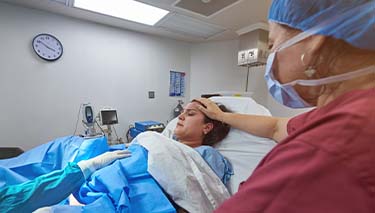It’s estimated that around five out of every 100 babies will be overdue, that is, born at more than 42 weeks gestation. And as if 40 weeks of pregnancy isn’t enough, tacking on an extra two weeks at the end can really make pregnancy seem endless.
When their baby’s due date has come and gone, lots of mothers start thinking creatively about how to bring on labour. There are a few natural ways to induce labour, for those who are keen to avoid having an induction of labour.
We don’t really know what initiates the onset of labour but it’s thought that somehow the baby’s brain communicates with the mother’s body for labour to start. Labour generally begins with contractions and/ or when the waters break.
Go for a walk or exercise
Any form of low impact exercise is helpful to get blood pumping and maintain a healthy metabolism. Although the last thing you may feel like doing is to get up off the couch and start moving, it’s likely this will help to make you feel better. Being upright will also help gravity do its bit by assisting the baby to move down into your pelvis.
Time your walks for a cooler time of the day. Include some gentle hills or slopes in your walking circuit. Listen to a podcast or your favourite music. Take a friend, your partner and if you have one, your dog for company.
Investigate pregnancy yoga or Pilates options, and let the instructor know you’re keen to find ways of how to induce labour.
Find ways to relax
Labour is more likely to start if you’re feeling relaxed and calm. Try having a warm, relaxing bath or shower and listen to some relaxation music. Book yourself in for a spa session and massage or, just quarantine some ‘me’ time.
If you have older children, accept all reasonable offers of help and childcare. Even a couple of hours could make a difference and help you find some time to rest.
Listen to some meditation apps or podcasts. Sit quietly and elevate your feet. Go for a swim (but not if your waters have broken). Book a massage, manicure or pedicure – whatever you prefer. Just remember not to lie flat on your back in case you go to sleep. Either side in late pregnancy is the recommendation from experts.
Sex
Semen has naturally occurring prostaglandins – a hormone which causes the uterus to contract. Getting up close and personal may be way down on your priorities right now, though some women do find their libido ramps up significantly during pregnancy.
Find a position in which you’re comfortable and don’t be in too much of a hurry to stand up after your partner has ejaculated. The semen needs to be in contact with your cervix to thin and dilate it.
Eat spicy food
The old wives tale about a good hot curry does not have any evidence to support it. However, if nothing else, eating a curry often has a flow on effect of stimulating the bowel to empty. Don’t go overboard if you’re prone to heartburn and just eat what suits you.
Acupuncture and acupressure
Followers of alternative therapies say that acupuncture and acupressure can be another way of inducing labour naturally. A review of the evidence in 2016 found that acupuncture showed some benefit in improving cervical maturity, though the authors reported that more trials are needed.
Do your own research about what is right for you and speak with your maternity care provider about your individual circumstances.
Nipple stimulation
Nipple stimulation is another natural way to induce labour. Either the woman or her partner massages her nipples, helping to stimulate the release of oxytocin. This is a hormone which makes the uterus contract.
There are varying opinions from maternity care providers about the effectiveness of nipple stimulation to stimulate labour. It can lead to hyperstimulation of the uterus and long contractions, resulting in the baby receiving less oxygen.
If you’re interested in nipple stimulation as a way of inducing labour naturally, speak with your maternity care provider. Some hospitals have their own policies around how and when this should be used.
Stretch and Sweep
Check with your maternity care provider about a procedure known as ‘sweeping the membranes’ or, a ‘stretch and sweep’. This is a procedure which is another way of inducing labour naturally.
The midwife or doctor does a vaginal examination and uses two fingers to stretch the cervix so it thins out. They will also try to separate the membranes (amniotic sac) from the cervix.
Although a stretch and sweep can be an uncomfortable procedure, it is often a useful way of inducing labour naturally. It is also a less invasive option of bringing labour on than an induction.
Medical induction of labour
Around 25% of pregnant women have an induction of labour. A medical induction can be recommended for the mother’s health e.g. hypertension, diabetes or other health concerns. A medical induction can also be advised for the baby’s health e.g. if they aren’t growing as they need to or, the placenta is no longer able to sustain the baby.
How is labour induced?
First you will have a vaginal examination so your cervix can be assessed. There are a few ways to induce labour, and depending on your history, one or a combination of methods will be recommended:
Artificial rupture of membranes (ARM)
This involves using a sterile hook to snag the membranes which the baby is in.
An ARM and a drip which contains oxytocin
This is a hormone which makes the uterus contract. The combination of ARM and oxytocin drip is a more common option of induction.
Prostaglandin gel
This is in a gel or a pessary which is inserted into the vagina and helps the cervix to soften and open.
Cervical ripening balloon catheter
This is when a thin tube or catheter with balloons at the end are inflated with saline. This helps the cervix to soften and open.
How overdue do I need to be before I’m induced?
As a general rule, induction is discussed when pregnancy has gone more than 10-12 days beyond the due date and there is a risk that the placenta cannot sustain the baby. Chat with your maternity care provider who knows your individual pregnancy history.
How effective are natural ways to induce labour?
It’s unclear what the true statistics are. Again, there are so many individual variables to take into account. Some people believe natural ways to bring on labour are very effective, others not so much. But as a general rule, inducing labour naturally is not harmful, as long as it is under the guidance of a qualified maternity care provider.
Written and reviewed by Jane Barry, midwife and child health nurse on 11/02/2020.


Last Published* May, 2024
*Please note that the published date may not be the same as the date that the content was created and that information above may have changed since.




















